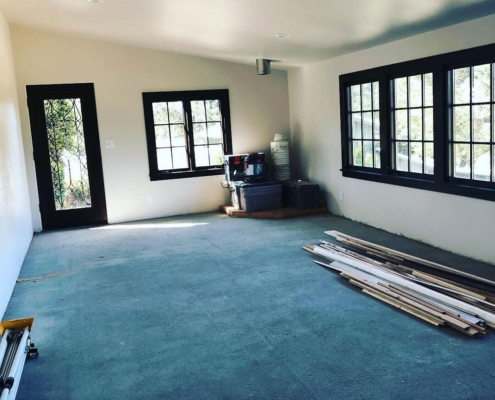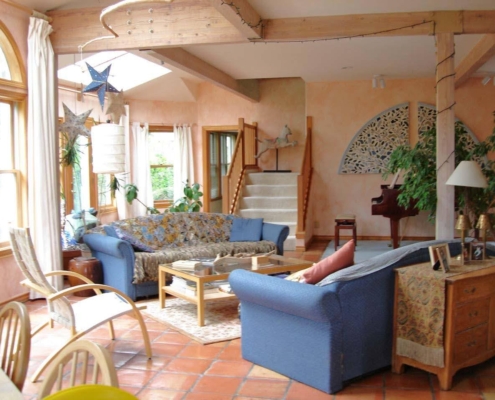Modular Homes and Ecowarm RadiantBoard
Radiant floor heating and in particular radiant heating modules like RadiantBoard is a great match for comfortable, energy-efficient modular homes.
- Ecowarm Radiantboard is a thin profile, low mass modular radiant floor system, a heating system that can be installed in the factory or on the job site without ducting.
- Cost Effective: Costs far less than leading radiant floor panel brands with the same efficiency.
- RadiantBoard means invisible heat and a small footprint combined hydronic mechanical solution. These radiant heating modules can use a gas-fired boiler or water heater heat source Gas Fired Mechanical Systems.
- High-efficiency system that requires lower supply water temperatures and faster response than underfloor radiant systems.
Radiant Heating Modules: A Smart Match for Modular Homes
As the modular construction industry continues to grow, there is increasing demand for energy-efficient, space-saving, and easy-to-install mechanical systems. Radiant heating modules, like Ecowarm RadiantBoard, are emerging as a preferred solution for builders, designers, and homeowners who prioritize comfort, sustainability, and performance. These modular heating solutions align perfectly with the streamlined, factory-built nature of modular home construction.
Unlike traditional forced-air systems that require large ducts and space-consuming HVAC components, radiant heating modules integrate easily into the floor system. This makes them ideal for modular environments where space is limited and simplicity is key. Because the heating system can be installed either at the factory or on-site, it provides flexibility to suit various building timelines and specifications.
Simplified Installation and Flexible Integration

One of the standout features of Ecowarm RadiantBoard is its ease of installation. The panels can be quickly placed on subfloors or sheathing, with PEX tubing routed in accordance with the factory-supplied layout. In a modular home build, where sections of the home are pre-fabricated off-site, this level of efficiency is essential.
Radiant heating modules are designed to be modular themselves, meaning they fit neatly into the structure of a modular home. Whether a builder is working with wood-framed sections, SIPs (Structural Insulated Panels), or steel framing, Ecowarm RadiantBoard adapts easily without the need for specialized tools or extended installation times.
These systems are also compatible with a wide range of heating sources. Whether you’re using a gas-fired boiler, an electric water heater, or a modern air-to-water heat pump, the Ecowarm system integrates with minimal changes. This versatility makes radiant modules one of the most adaptive radiant heating systems for homes.
Energy Efficiency and Low Operating Costs
Homeowners are increasingly prioritizing sustainability and energy savings. Radiant heating modules address both concerns by operating at lower water temperatures compared to traditional systems. This means that less energy is required to heat the home, which directly translates into lower utility bills and a reduced carbon footprint.
For example, while many radiant floor systems require supply water temperatures in the 95°F–120°F range, Ecowarm’s low-mass panels can typically operate with water temperatures as low as 80°F–95°F. This makes them particularly well-suited for use with high-efficiency condensing boilers and renewable energy sources like solar thermal systems or heat pumps.
Enhanced Comfort and Air Quality
Comfort is a top reason many homeowners choose radiant heat. By distributing warmth evenly from the floor up, radiant heating panels ceiling mounted or floor-installed eliminate the cold spots and drafts commonly associated with forced-air systems. There are no noisy fans or ducts moving allergens, dust, or bacteria around the home.

In modular homes, where design often favors open layouts and clean finishes, radiant heating offers invisible comfort. The system operates silently and doesn’t interfere with furniture placement or interior aesthetics.
Ideal for Modern and Luxury Modular Homes
Radiant heating systems aren’t just for high-end custom homes. With the modular construction sector pushing boundaries in modern design, radiant heating modules offer a premium feel without a luxury price tag. Their thin profile and low-mass design make them an attractive option for compact builds as well as high-performance energy-efficient homes.
Modular builders can now offer radiant heating in ceiling or floor systems as part of their standard or upgrade packages, adding value to their offerings while differentiating from competitors who still rely on conventional heating methods.
FAQ’s
1. What is Radiant Heat in a House?
Radiant heat in a house is a system where warmth is delivered through surfaces like floors, walls, or ceilings rather than through air vents. It typically uses water-filled tubing (hydronic) or electric coils embedded in panels that radiate heat into the room. This creates even, consistent warmth that feels natural and comfortable. Radiant systems are silent, efficient, and eliminate the need for bulky ductwork, making them ideal for modular homes and modern construction.
2. Are Radiant Heating Systems Good for Modular Homes?
Yes, radiant heating systems are an excellent match for modular homes. They require no ductwork, are energy-efficient, and can be factory-installed or added on-site. Their modular design fits perfectly with the pre-fabricated nature of modular construction.
3. Can I Install Radiant Heat in Just One Part of My Modular Home?
Yes, radiant systems are modular and flexible. You can install them in specific zones like bathrooms, bedrooms, or living areas — or throughout the entire home, depending on your needs and budget.
4. How Thick are Radiant Heating Modules like Ecowarm RadiantBoard?
Ecowarm RadiantBoard is a thin, low-profile system that adds minimal height to the floor assembly — an important feature for modular homes where space efficiency is critical.
